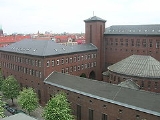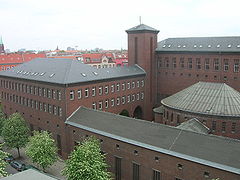
Kopenhagener Straße
Encyclopedia

Berlin
Berlin is the capital city of Germany and is one of the 16 states of Germany. With a population of 3.45 million people, Berlin is Germany's largest city. It is the second most populous city proper and the seventh most populous urban area in the European Union...
's Prenzlauer Berg
Prenzlauer Berg
Prenzlauer Berg is a locality of Berlin, in the borough of Pankow.Until 2001, Prenzlauer Berg was a borough of Berlin; in that year it was included in the borough of Pankow....
district runs parallel to the Ringbahn tracks between busy Schönhauser Allee in the East all the way to the Mauerpark
Mauerpark
Mauerpark is a public park in Berlin's Prenzlauer Berg district. The name translates to "Wall Park", referring to its status as a former part of the Berlin Wall and its Death Strip...
in the West, where the Berlin Wall
Berlin Wall
The Berlin Wall was a barrier constructed by the German Democratic Republic starting on 13 August 1961, that completely cut off West Berlin from surrounding East Germany and from East Berlin...
separated the Soviet
Soviet Union
The Soviet Union , officially the Union of Soviet Socialist Republics , was a constitutionally socialist state that existed in Eurasia between 1922 and 1991....
from the French
France
The French Republic , The French Republic , The French Republic , (commonly known as France , is a unitary semi-presidential republic in Western Europe with several overseas territories and islands located on other continents and in the Indian, Pacific, and Atlantic oceans. Metropolitan France...
sector. The street was named on 30 April 1899 after the Danish
Denmark
Denmark is a Scandinavian country in Northern Europe. The countries of Denmark and Greenland, as well as the Faroe Islands, constitute the Kingdom of Denmark . It is the southernmost of the Nordic countries, southwest of Sweden and south of Norway, and bordered to the south by Germany. Denmark...
capital Copenhagen
Copenhagen
Copenhagen is the capital and largest city of Denmark, with an urban population of 1,199,224 and a metropolitan population of 1,930,260 . With the completion of the transnational Øresund Bridge in 2000, Copenhagen has become the centre of the increasingly integrating Øresund Region...
.
At a length of 800 metres (1 half mile) it features a nearly complete row of 61 apartment buildings built in the Jugendstil period with 4 modern houses and playgrounds in between. From East to West it is intersected by Rhinower Straße, then crossed by Sonnenburger Straße, by Ystader Straße and finally ends at Schwedter Straße at the northern end of the Mauerpark. At Sonnenburger Straße the Schönfließer Brücke, built in 1908 according to plans by Alfred Grenander
Alfred Grenander
Alfred Frederik Elias Grenander, , was one of the most prominent architects during the first building period of the Berlin U-Bahn in the first half of the twentieth century....
, crossed the Ringbahn railway towards the north up until the end of World War II, when it was intentionally detonated to provide a hindrance to the advancing Soviet troops. Three buildings in the Kopenhagener Straße were destroyed in the process. As a replacement, a 60 m (200 ft) long pedestrian bridge was installed right beside during the governance of the German Democratic Republic (GDR).
A study prepared by the geography department at the Humboldt University of Berlin
Humboldt University of Berlin
The Humboldt University of Berlin is Berlin's oldest university, founded in 1810 as the University of Berlin by the liberal Prussian educational reformer and linguist Wilhelm von Humboldt, whose university model has strongly influenced other European and Western universities...
counted 45 different artists in the street, making this one of Berlin's significant creative functional clusters. Further one finds very many cafés, restaurants, bars and the infamous Mittwochsclub (Wednesday Club, located in the cellar under the Kohlenquelle Café in No. 16). The most obvious structure in the street is the former Humboldt transformer station at No. 61 (on the corner of Sonnenburger Straße), that was planned by the renowned German industrial architect Hans Heinrich Müller. An experimental urban children's farm (the Moritzhof) is located at the western end of the Kopenhagener Straße, providing the surreal view of horses and goats against a backdrop of dense urban housing and the Fernsehturm.
The Kopenhagener Straße was inhabited by artists and bohémiens much before German reunification
German reunification
German reunification was the process in 1990 in which the German Democratic Republic joined the Federal Republic of Germany , and when Berlin reunited into a single city, as provided by its then Grundgesetz constitution Article 23. The start of this process is commonly referred by Germans as die...
. Despite the renovation and revival of the majority of the buildings since the fall of the Berlin Wall in 1989, the cobblestone
Cobblestone
Cobblestones are stones that were frequently used in the pavement of early streets. "Cobblestone" is derived from the very old English word "cob", which had a wide range of meanings, one of which was "rounded lump" with overtones of large size...
street at the northern rim of Berlin's city centre has maintained its pre-unification calm and creative charm. For this reason the Kopenhagener Straße was selected as the movie set for several movies that indulge in GDR Ostalgie
Ostalgie
Ostalgie is a German term referring to nostalgia for aspects of life in East Germany. It is derived from the German words Ost and Nostalgie ....
, for example Der Rote Kakadu and Sommer vorm Balkon. Aside from artists, many actors, authors and architects also have made the street their home or place of work. Approximately half of the current residents lived in the street before reunification. Newer inhabitants are mostly from former West Germany
West Germany
West Germany is the common English, but not official, name for the Federal Republic of Germany or FRG in the period between its creation in May 1949 to German reunification on 3 October 1990....
and other European countries.
External links
- Transformer Station Kopenhagener Straße
- Kinderbauernhof im Mauerpark
- Roter Kakadu Official Movie Page
- Sommer Vorm Balkon Official Movie Page
Source
- Die Kulturmeile - Raum für Kunst in der Kopenhagener Straße, Tagesspiegel 20th of November 2006

